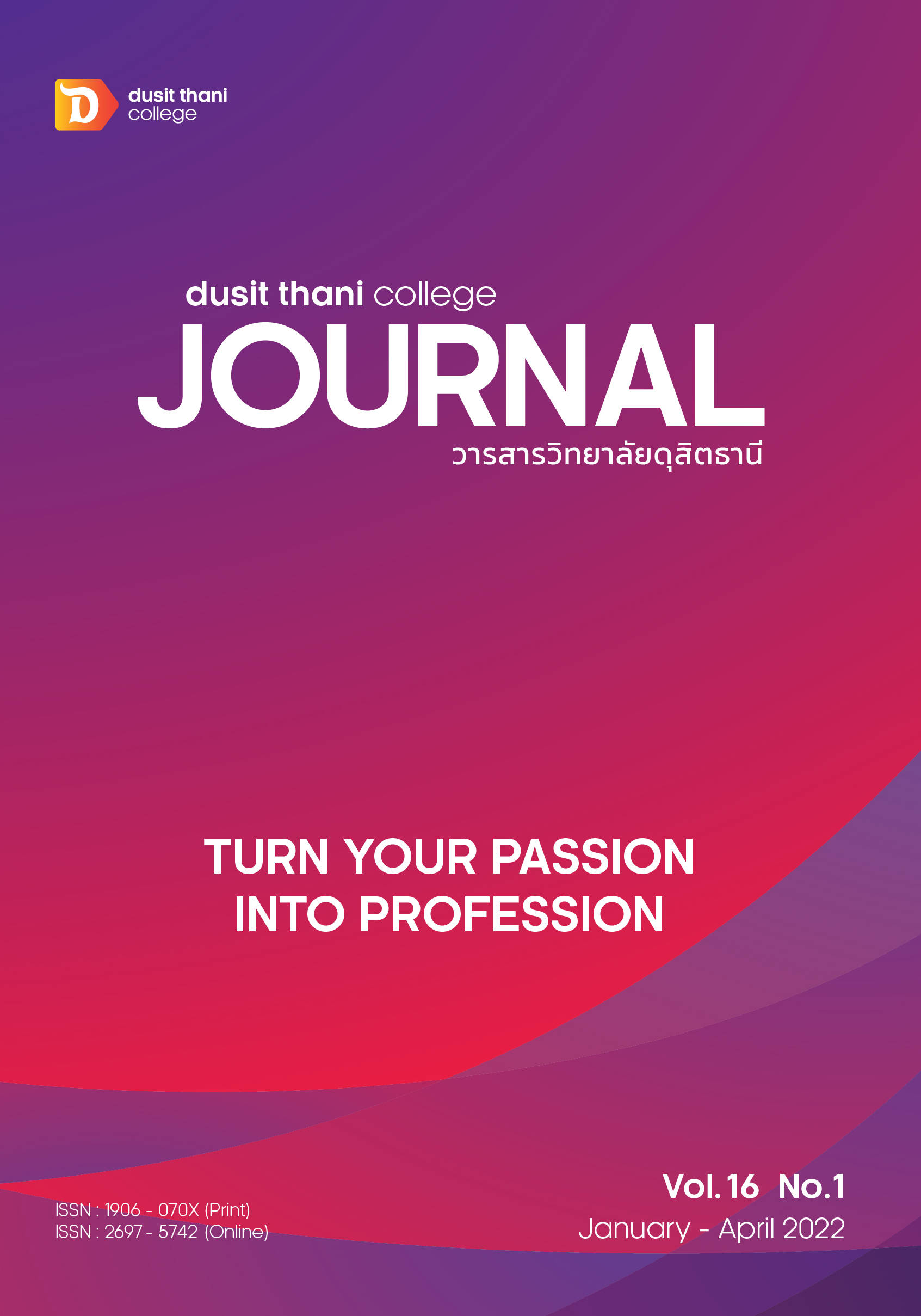The Development of Tourism Learning Route with Muangmadan Community Participation in Tambon Tasai and Tambon Bang-or, Nakhon Nayok Province
Main Article Content
Abstract
The purposes of the research were (1) to study a potential of local community towards the community-based tourism activities management in the Muangmadan community Nakhon Nayok province, (2) to study the community participation for learning tourism activities management in Muangmadan community, (3) to study the behavior of Thai tourists intersted in learning tourism activities in Muangmadan community; and (4) to develop of tourism learning route with Muangmadan Community participation. This research was mixed method research conducted in-depth interviews with a total of 15 key informants, including community leaders and community product producers and distributed a questionnaire for 155 tourists. The content analysis and descriptive statistics such as frequency, percentage, mean, and standard deviation were applied for data analysis. The research result showed that overall, (1) the community has potential for learning tourism activities according to the knowledge, skills, attitudes, and core competency in Muangmadan community. 2) People in the community participate in development in Muangmadan community-based tourism in 4 ways directly and indirectly including 1) planning, 2) cooperating, 3) sharing, and 4) evaluating. (3) The overall behavior of Thai tourists towards learning tourism activities was rated at the high level. (4) The development of tourism learning route with Muangmadan community Participation can be created into 2 routes which are One day trip and 2 days 1 night.
Article Details

This work is licensed under a Creative Commons Attribution-NonCommercial-NoDerivatives 4.0 International License.
Article Screening Policy
- All research and academic articles to be published must be considered and screened by three peer reviews in the relevant field / article.
- All articles, texts, illustrations and tables published in the journal are the personal opinions of the authors. Editors don't always have to agree. And no responsibility whatsoever is the sole responsibility of the author.
- The articles to be published must never be published. Where did you first publish? And not in the consideration of other journals If the audit found that there has been a duplicate publication It is the sole responsibility of the author.
- Any article that the reader sees as being plagiarized or impersonated without reference. Or mislead the work of the author Please let the journal editor know it will be your greatest blessing.
References
Andrea Yanes, S. (2019). Community-Based Tourism in Developing Countries: A
Frameworkfor Policy Evaluation. Retried Sustainability 2019, 11, 2506.
www.mdpi.com/journal/sustainability
Aref, F. (2011). Barriers to community capacity building for tourism development in communities in Shiraz, Iran. Journal of Sustainable Tourism, 19(3), 347–359.
Ellis, S. (2011). Community based tourism in Cambodia: exploring the role of community for successful implementation in least developed countries. Retrieved from https://ro.ecu.edu.au/theses/451
Hounslow, B. (2002). Community capacity building explained Stronger Families Learning Exchange. Bulletin, 1, 20-22.
Krejcie, R. V. and Morgan, D. W. (1970). Determining Sample Size for Research Activities. Educational and Psychological Measurement, 30(3), 607-310.
Kaewsanga, P. and Chamnongsri, N. (2012). Creative Tourism: A New Choice of Thai Tourism. Suranaree Journal of Social Science, 6(1), 91-109. (in Thai)
Kaswanto, N. (2014). Land suitability for agrotourism through agriculture, tourism,
beautification and amenity (ATBA) method. Department of Landscape Architecture, Faculty of Agriculture, Bogor Agricultural University, Meranti St. Dramaga, Bogor 16680, Indonesia.
Lamaijeen, K., & Choibamroong, T. (2015). A potential of local community towards the community-based tourism management in U-Thong ancient city, Suphanburi province. Rajabhat J. Sci. Humanit. Soc. Sci.17(1): 190-199. (in Thai)
Nakhonnayok Provincial Office. (2019). Nakhon Nayok Province Development Plan 2018- 2021. Retrieved May 30, 2019, from http://www.nakhonnayok.go.th/ (in Thai)
Page, S. J. & Hall, C. M., (2009). Progress in Tourism Management: From the geography of
tourism to geographies of tourism–A review. Tourism Management, 30(1), 3-16.
Prajong, S, Boonkoum, W, & Sangrugsa, N. (2017). Participatory Action Research in
Community-Based Tourism ActivitiesAccording to the Philosophy of Sufficiency Economy to Strengthen Community Economy at NakhonRatchasima ProvinceVeridian E-Journal, Silpakorn University (Humanities, Social Sciences and arts), 10(2), 1515-1529. (in Thai)
Ratchathawan, R., Kaewkrajok, T., Jongkatekit, W., Phromkaew, P., Sumdangsan, D., & Thonglert, D. (2018). The Community Participation Process in Well-being Development. JOURNAL OF SOUTHERN TECHNOLOGY, 11(1), 231-238. (in Thai)
Richards, G. and Wilson, J. (2006). Developing creativity in tourist experiences: A solution to the serial reproduction of culture. Tourism management27: 1209–1223.
Rongthong, N., & Thosuwonchinda, V. (2020). Guidelines for the Development of the Potential Tourism Model, Baan Sa Kla Village Samut Prakarn Province. Dusit Thani College Journal, 14(1), 109-129. (in Thai)
Sirichana, N. (2020). Muangmadan Community Tourism Promotion Conference @Nakhon Nayok. Retrieved May 30, 2019, from http://nknayok.nso.go.th/index.
(in Thai)
Sungsuwan, T. (2018). Creative Tourism in Koh Samed: The Answer for Sustainable tourism? NIDA Case Research Journal, 10(2). (in Thai)
Tancharoen, S. (2018). Community Based Tourism Management and Sustainable Tourism Development of Bangkantaek Community in Samutsongkhram Province. Academic Journal of Phetchaburi Rajabhat University, 8(2). (in Thai)
Tourism Authority of Thailand. (2016). Tourism Marketing Promotional Press Release 2017.
Plenary Hall Queen Sirikit National Convention Center.
Tourism Authority of Thailand. (2019). Tourism Marketing Promotional Press Release 2020.
Plenary Hall Queen Sirikit National Convention Center.
Thailand Community Based Tourism Institute. (2006). The travelling route for CBT. Retrieved May 30, 2019, from https://cbtyouth.wordpress.com/cbt-youth/cbt/
UNESCO. (2006). Towards Sustainable Strategies for Creative Tourism, Discussion Report of the Planning Meeting for 2008 International Conference on Creative Tourism Santa Fe, New Mexico, U.S.A. October 25-27, 2006.
Wurzburger, R., Pratt, S., & Pattakos, A. (Eds.). (2009). Creative tourism, a global conversation. Sunstone Press.
Wurzburger, R. (2010). Creative Tourism A Global Conversation how to provide unique
creative experiences for travelers worldwide: at present at the 2008. Santa Fe & UNESCO International Conference on Creative Tourism in Santa Fe. (pp. 15–25). New Mexico. USA.


